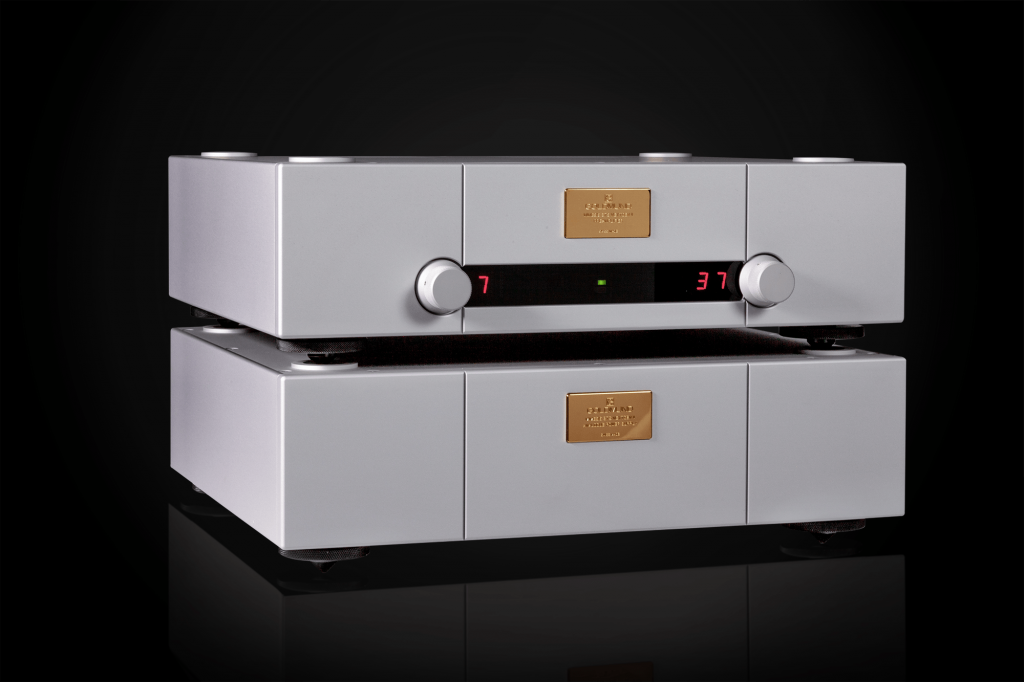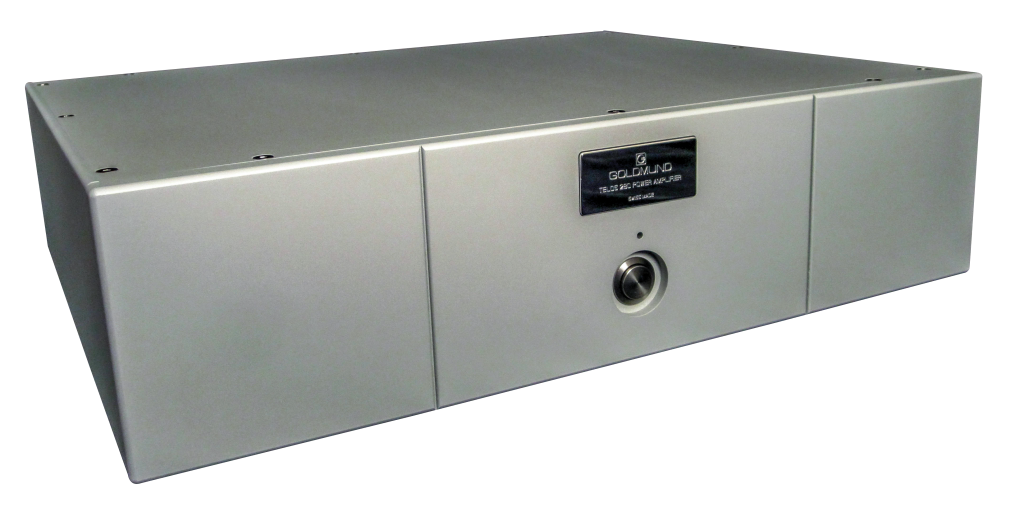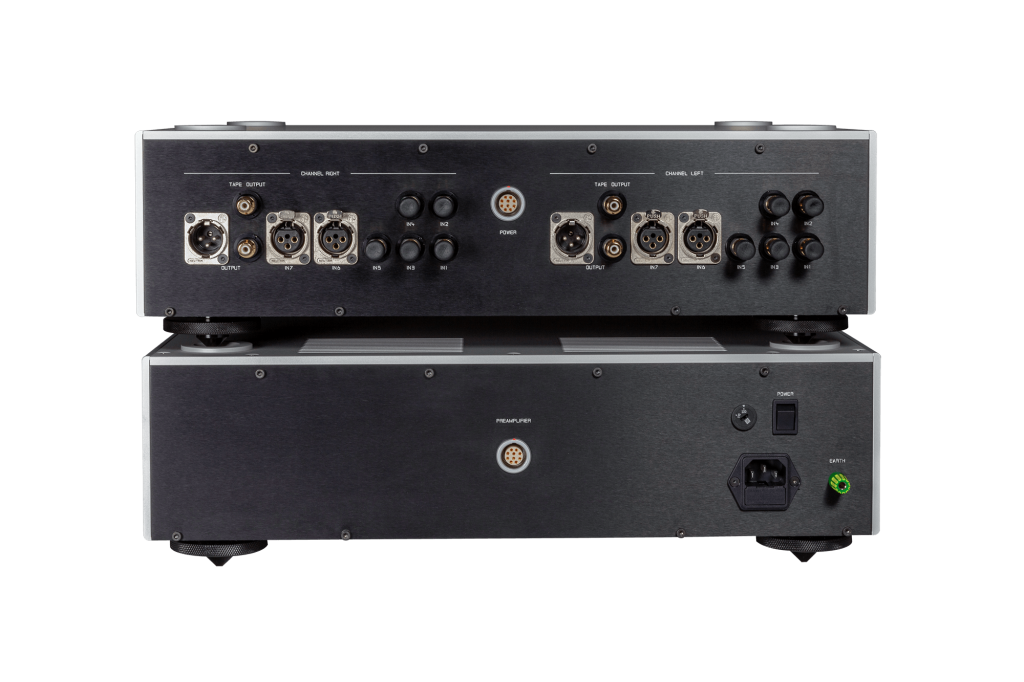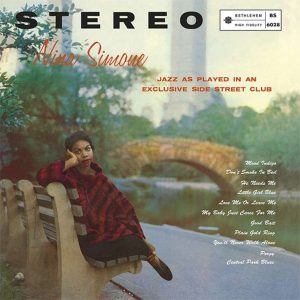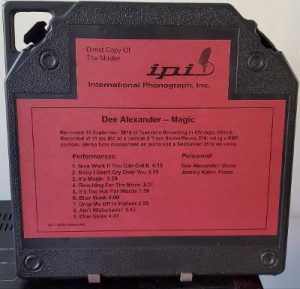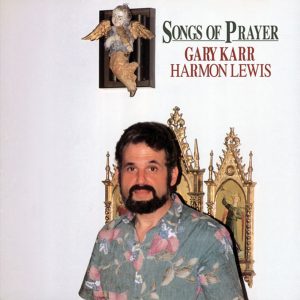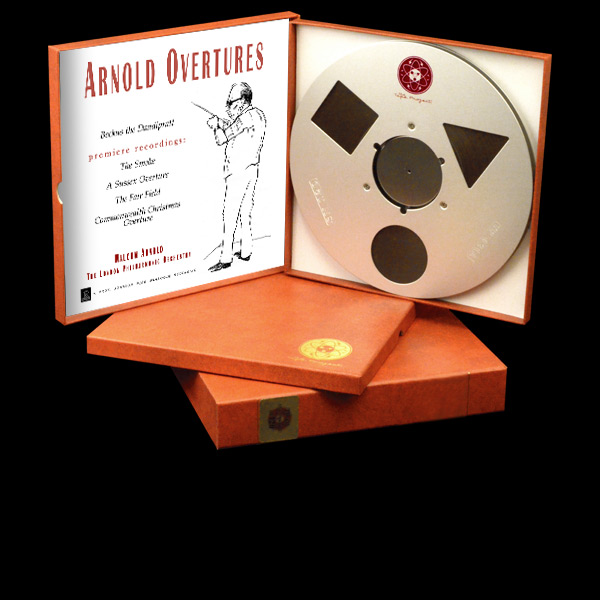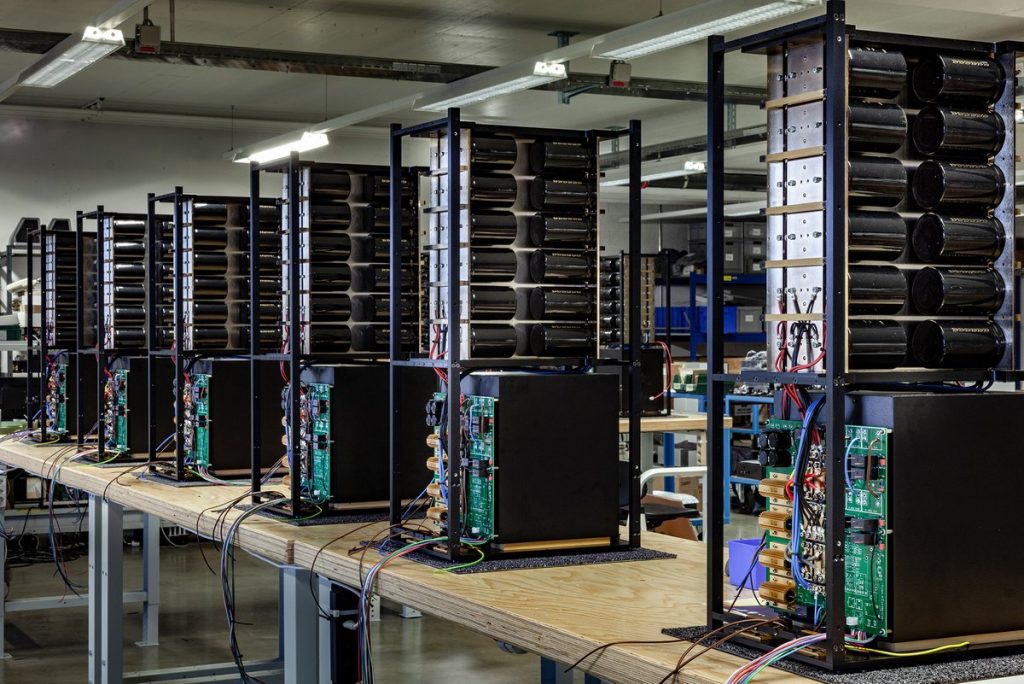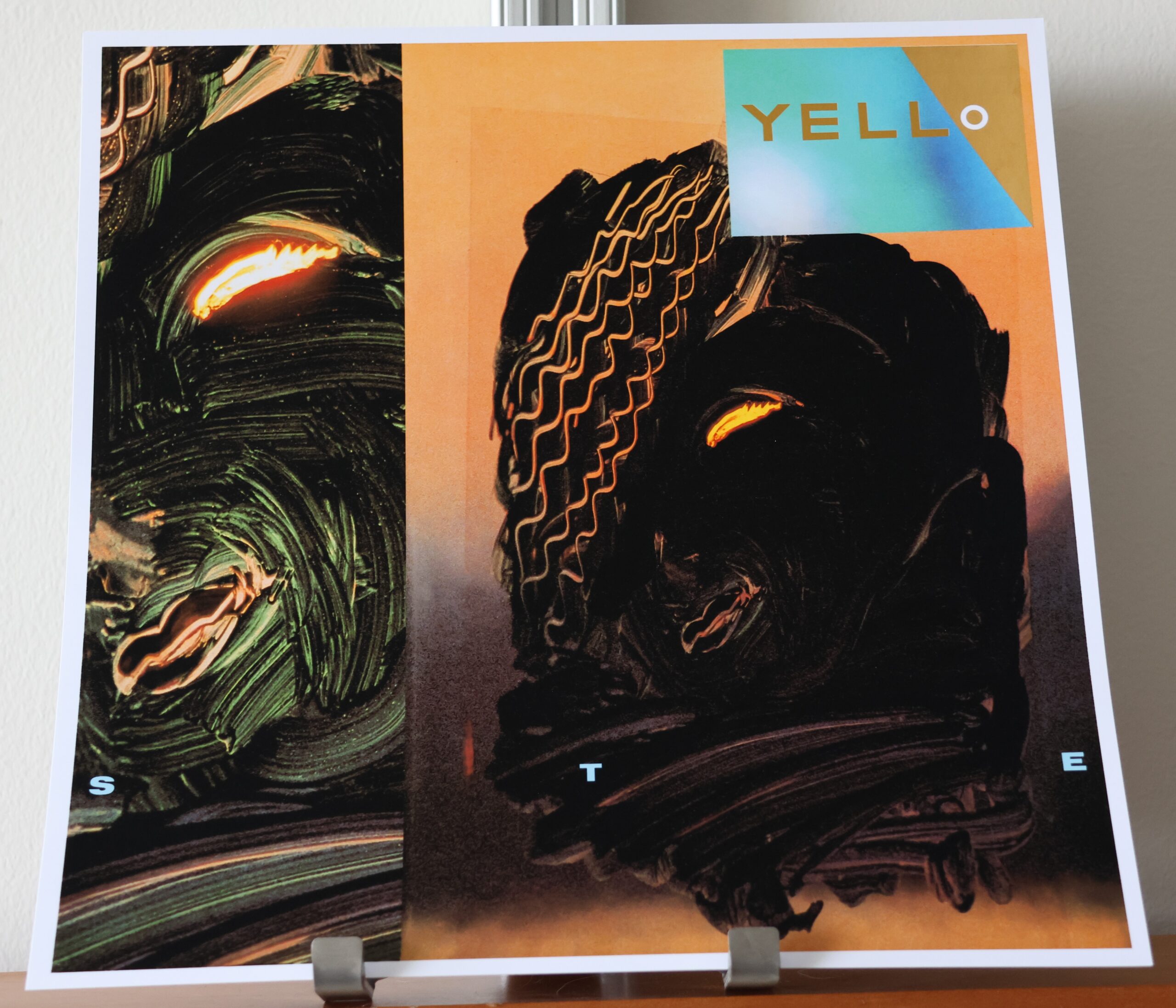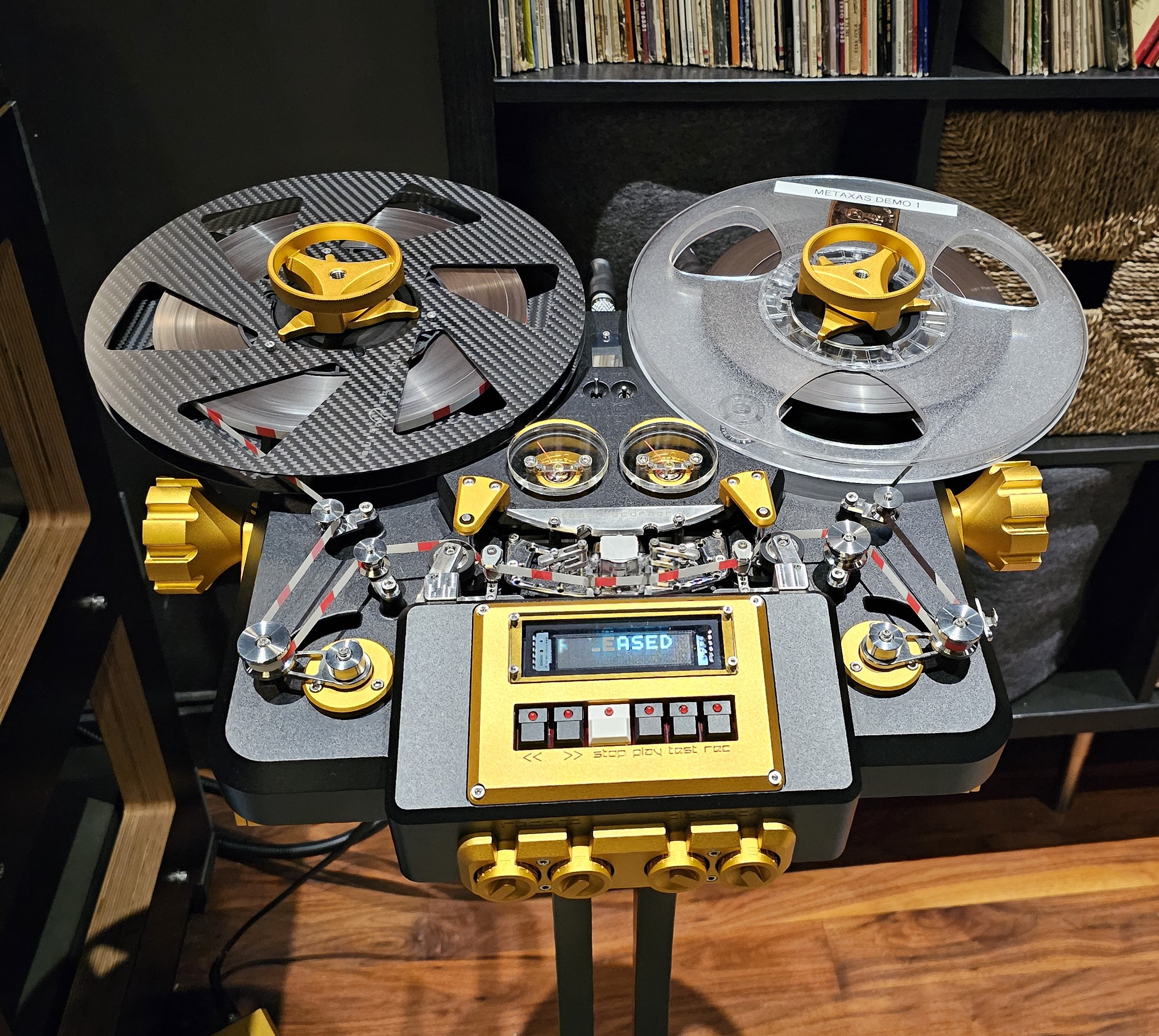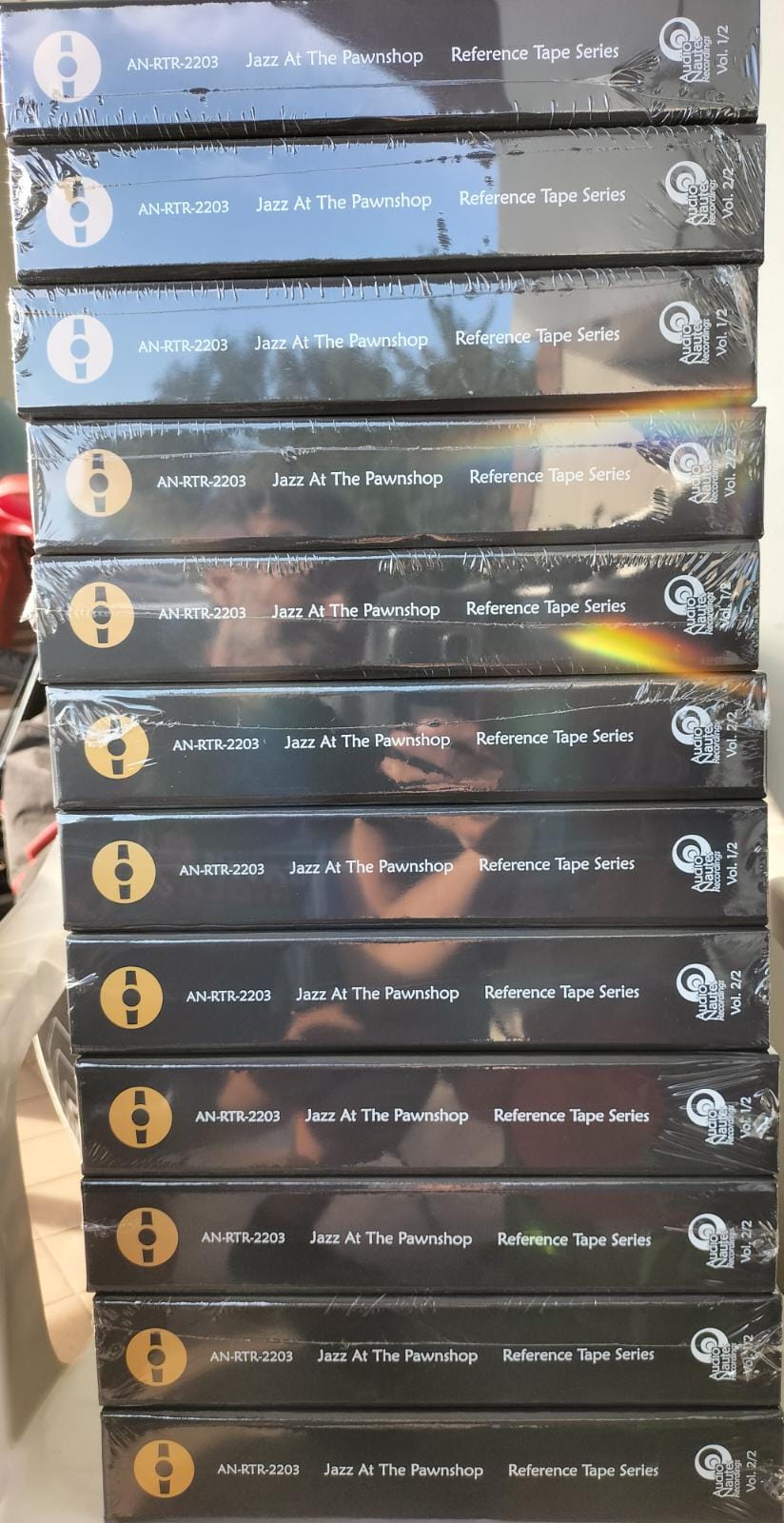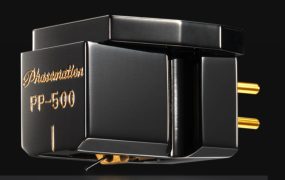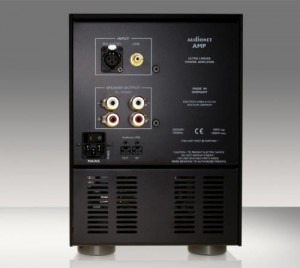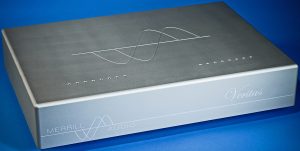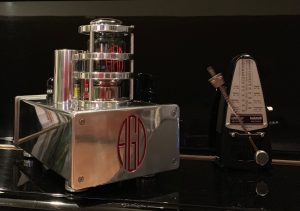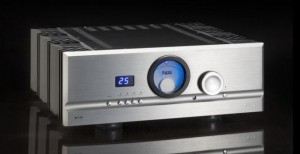I was once upon a time in a galaxy far, far way, an unabashed, dyed-in-the-wool tube lover. The mere mention of solid-state electronics sent my upper lip into involuntary quivering. Still, it was important to separate my job as an audio reviewer from my personal preferences. Over the years, products from Levinson, Rowland, Cello, PASS, Goldmund, Merrill Audio, and probably a few other companies long forgotten have passed through my reference system. This year alone has seen solid-state electronics from Ensemble (hybrid integrated), Merrill Audio, and the subject of this review the Goldmund Mimesis 37S NextGen analog preamplifier and Telos 280 stereo analog power amplifier from Switzerland in house for review.
Goldmund is one of high-end audio's premier companies and true elder statesmen. Goldmund as Herman Hesse fans might remember, was a talented artist in "Narcissus and Goldmund" who leaves the Catholic monastery and embarks on a journey to find the meaning of life. Like Hesse's Goldmund, the company's goal was since day one to set the standard by which other audio products are judged, and to "transform every listening activity into a concert-like experience."
Team Swiss
The Telos 280 stereo amplifier and newly updated two piece Mimesis 37S NextGen preamplifier are the first Goldmund products to come my way since the original entry level Job amplifiers back in the late 1990s. Luckily Goldmund's exclusive US distributor, Gideon Schwartz of AudioArts NYC, delivered and installed both pieces just before the pandemic hit and shut down New York City in March. The circuitry and design inside both the Telos 280 amplifier and Mimesis 37S NextGen preamplifier draw heavily from Goldmund's in house R&D work that produced the Leonardo time alignment, and Telos amplifier technology as well as mechanical grounding (see Technical Highlights). Both products sounded great out of the box, but they definitely improved with playing time. Mind you, not earthshattering changes, but little things here and there including finesse, fleshing things out, and control.
Early on in the course of this review I decided to really put these electronics through their paces using a variety of sources and cabling (New York City's Covid-19 crisis, unfortunately, prevented me from returning my reference Transparent Audio cabling for retuning). Analog sources included my modded Technics RS-1506 reel-to-reel deck outfitted with low inductance Flux Magnetics heads feeding (balanced) a Doshi Audio V3.0 tapestage playing back a variety of 15-ips reel-to-reel tapes. Alternatively, my VPI Vanquish direct-drive table outfitted with either the SAT LM-12 tonearm or the VPI 12-inch gimballed arm spun LPs. The Fuuga cartridge from Japan was mounted in the VPI arm while the Mutech Hayabusa cartridge (also from Japan) currently in house for review saw service in the SAT arm. A variety of cables were also used, including Audience's Au24SX interconnects and speaker cable, and either Audioquest's Dragon Zero or Thunderbird speaker cables. There was also an opportunity towards the very end of the review project to substitute a length of Audience's newest frontRow interconnects into the system between the Doshi V3.0 tapestage and Mimesis 37S NextGen preamplifier. Power cables included Ensemble's Dalvivo on the preamplifier, and Kubala-Sosna Emotion on the amplifier (because the Emotion was the longest power cord around, and the pandemic limited things a bit). It was clear as day that cables possessing the lowest noise floors really maximized the Goldmund electronic's transparency. Audioquest's Dragon Zeros were, for instance, the quietest, fastest, and most transparent of the speaker cables. While the Dragon Zeros had the best bass and dynamics, the Audioquest Thunderbird speaker cables had a bit more ease, dimensionality, smoothness, and fleshed out midrange, and saw the most use during the review.
The very first thing I noticed about the Goldmund pairing was their knack to bring out the best in recordings. Even those recordings that weren't particularly noteworthy sounded better. Take, for example, the opening track "Mood Indigo" from the recent 45 rpm reissue of Nina Simone's Little Girl Blue (Analogue Productions APJ 083-45). While there's no overlooking those little imperfections in this early 1957 stereo recording, these warts never interfered with enjoying Nina's debut album on the Bethlehem label. Why? Because this pairing simply nails it in that ever so critical midrange. The Telos 280 amplifier and Mimesis 37S preamplifier don't attempt to emulate the sound of tubes by slightly darkening the sound, or softening the transients to give the appearance of more musical overtones. No. The Telos 280 amplifier and Mimesis 37S preamplifier's loyalty is to the music, not solid-state or tube camps. Just the whole truth, nothing but the truth. Nina's voice is rich, vibrant, sultry, smooth, and expressive with subtlest of reverb thrown in for good measure. There's nothing preventing your mind's eye from seeing her. There's no trace of solid-state analytical clinical sound here nor added midrange emphasis / exaggeration. It's as if Nina was reincarnated and is standing in the room singing into a microphone. There's even the eerie feeling of her mouth moving while she sings. Imaging crosses three-dimensional barrier and enters the corporeal realm. Shockingly better than any tube amplifier because of the increased transparency / decreased noise floor. (A quality brought out by the Audience cabling.)
At the same time, the Goldmund gear has a special ability to bring out the best in the ancillary equipment. Audience's Au24SX cables were a bit more open and transparent than I gave them credit for a while back. (HERE). The Fuuga cartridge sounds even quicker and more resolving than originally thought. (HERE) The VPI Vanquish direct-drive table and SAT LM-12 tonearm demonstrates among other things greater lower octave extension and transparency. I think you get the general idea: this is a total system makeover.
What stands out the most—perhaps the effect of living for what seems like an eternity now with tube electronics—is the Telos 280 amplifier's and Mimesis 37S NextGen preamplifier's vanishingly low noise floor. Harry Pearson always had a special knack for turning a phrase, and one that stands out here is, "the absence of noise is not the presence of music." That's clearly not the case here and in fact just the opposite is true. Living with this combination from Goldmund for the better part of four months proves, without a doubt that a component's noise floor level affects musical reproduction in ways we haven't considered such as low level resolution, musical flow, and dynamic contrasts. Even listener fatigue.
Take the direct-to-disc recording of Radames Gnattali's "Sonata For Guitar and Cello" from Laurindo Almeida Virtuouso Guitar (Crystal Clear CCS 8001). This record (among a group of albums) has always been slightly on murky sounding side. While the degree of murkiness on this recording has improved over the years, it's never completely vanished. That is until now. Here the Goldmund's vanishingly low noise floor coupled with the extremely low noise floor of VPI's Vanquish direct-drive turntable, the settling time of the Magico S5 Mk. 2s, and the appropriate cabling markedly improved this direct-to-disc's transparency, allowing more music to emerge. This new found transparency brings out the melody, rhythm and liveliness of Almeida's guitar, a greater sense of Frederick Seykora bowing his cello in addition to a greater openness.
Jonathan Horwich's wonderful Dee Alexander Magic (Int. Phonograph Inc., 15 ips tape, direct copy) recorded at Tone Zone Recording in Chicago superbly illustrates the Telos 280 amplifier and Mimesis 37S Nextgen's midrange character. Jonathan, after careful comparisons, chose the legendary Telefunken 251e microphone (based on AKG's C12 mike and only produced for three years from 1959-62) to capture Alexander's voice. He chose the legendary Telefunken 251e over the Telefunken U67, "because the former [microphone] was more transparent, cleaner and smoother than the U67." By contrast, "the U67," Jonathan added, "tended be slightly euphonic." Jonathan also used the Telefunken 251e in a cardioid pickup pattern to better to isolate Alexander's voice and prevent bleed over to the microphones on the piano or drums. A custom-made stereo KMF Audio omni-directional tube microphone was used on accompanist Jeremy Kahn's piano. This long time Chicago-based jazz singer performs on Magic nine of her own arrangements of jazz standards, including the likes of "Blue Monk" and "Blue Skies." It's apparent from the get-go that the Telos 280 amplifier and Mimesis 37S NextGen preamplifier don't embellish upon, nor subtract from the music. Alexander's voice is just so pure sounding, and her phrasing exquisitely rendered. There's nary a trace of grain or artificiality, and those teeniest nuances that bring music to life are there in spades. Alexander is perfectly positioned between the speakers, perhaps a bit closer up than with the conrad-johnson electronics. The melody line of Kahn's piano is perfectly preserved, and the sense of the piano's strings, soundboard, the resonance of the piano body and decay of notes are mouth wateringly recreated. Oh yes, Jonathan is a stickler when it comes to correctly capturing the piano and it shows.
Handling densely orchestrated music presents no problem for this dynamic duo either. One album that's proved a serious challenge for all equipment for decades—cartridge/arms, electronics and speakers alike—is Yasukazu Amemiya's Summer Prayer for Solo Percussionist, Tape and Percussion Ensemble (RCA 45R10JRL1-1155). Amemiya composed Summer Prayer during his ‘70s stay in the US, and the piece was debuted by the Manhattan Percussion Ensemble in 1974. Summer Prayer resided on HP's recommended list around Issue 8 of The Absolute Sound, but then for some mysterious reason the album went MIA. I discovered by sheer accident two years ago that RCA Japan had actually released a 45 rpm version of this album (minus one song). This composition for soloist, five performers, and pre-recorded tape in a polyphonic relationship is an absolute torture test because of its dynamic range from soft to loud, lack of compression, and extreme high frequency content. One thing is for sure, don't be tempted into turning up the volume at the opening of Summer Prayer or your eardrums will shortly bear the consequences. Here we have a potpourri of instruments with those at the front being placed a little more forward than normal. Don't mistake this, however, to mean the whole soundstage is shifted forward. There's actually more depth on this recording, and greater layering of instruments between the front and rear boundaries of the soundstage. The Telos 280 amplifier or Mimesis 37S never lose control on this album no matter the complexity or density of the music. This album takes on dynamics and speed, especially with the Fuuga, that just weren't happening before.
Summer Prayer also reveals a lot about pairing the Telos 280 amplifier with the Magico S5 Mk. 2 speakers. Magico's S5 Mk.2 speakers are extremely linear, extended, and uncolored through the bottom most octaves, and prove a stern test for many amplifiers. Colorations, lack of extension, bloating, and other issues in this region are instantly and ruthlessly revealed. No problems here. The drums display unfettered dynamics, endless detail, and Usain Bolt-like speed. Dynamics go from 0 to 200 mph in a heartbeat. At the same time these amplifiers demonstrate an uncanny ability to capture the smallest details such as the tension of the drum head and the thickness of the skin.
Gary Karr and Harmon Lewis's Songs of Prayer (Analogphonic CNLR1338) further illustrates the Telos 280 amplifier's low octave performance. The organ on "O Holy Night" plumbs the depths along with an impressive ability to move air and pressurize the room. Karr's cello sounds occupy a space in the front of the hall while the organ defines the back, side, and overhead boundaries of the recording space. Nor does the Telos 280 blow Karr's cello up to the size of the organ, as can happen with other amplifiers. What stood out the most, however, is the amplifier's mid-bass performance. The Telos 280 amplifier neatly sidesteps that tradeoff between detail / leaness and warmth of many solid-state amplifiers. The Telos 280 amplifiers are extremely believable in the mid-bass region, delivering the right proportions of warmth, detail, and resolution.
The Telos 280 stereo amplifier and Mimesis 37S NextGen preamplifier combination aren't fazed one bit either when confronted with large scale orchestral music such as The Tape Project's 15 ips reel-to-reel tape release of Malcolm Arnold's Arnold Overtures (Reference Recordings/The Tape Project TP 003). Take for example, the Commonwealth Christmas Overture and its unpredictable nature particularly the third section / interlude where the listener is magically transported to the West Indies, and healthy dose of calypso music and the accompanying instruments including electric guitar and percussion. Looking back on my notes. Effortless and unstrained. The soundstage and sense of space is enormous. Something that not so long ago was the province of tubes. Feel like I'm hearing Watford Town Hall for the first time rather than listening to an audio system. The tone and timbral quality of strings and reed instruments is beautiful. Really captures the tension, ebb and flow of the piece. I'm hearing inner voices of the orchestra and decays that weren't there before. All in all, a thoroughly exhilarating experience.
Now there is one small downside to this massive soundstage. There's a tendency on some early stereo recordings—take the Blue Note jazz LPs—to pull instruments further apart than the conrad-johnson ART300 amplifier and GAT Series 2 preamplifier.
Finally, a "custom" designed Silent Running Audio OHIO Class XL+2.1 platform for the Telos 280 amplifier arrived just before wrapping up this review. Silent Running Audio's OHIO .1 bases incorporate designer Kevin Tellekamp's latest thinking on human psychoacoustics and an entirely new anechoic coating. Now what does this mean for the Telos 280 amplifier? According to importer Schwartz, "Goldmund amplifiers, due to their mechanical vibration evacuation, benefit immensely from proper foundation." The reality is siting the Telos 280 amplifier conservatively elevated its performance by a good half a star. The two most apparent improvements on Greg Ward's At Pro Musica 15-ips tape (International Phonograph, Inc., direct copy) were that instruments were 1) much more palpable and 2) displayed a greater ability to project their sound. Have a listen to Ward's alto saxophone and his vibrato on "Stomping at the Savoy," or the nimbleness of his saxophone on "April in Paris!" The music just swings so effortlessly.
Another Circle Achieved
This solid-state amplifier sounded like a tube amplifier. That solid-state amplifier sounded like a single-ended tube amplifier (though personally never experienced that). We've all read reviews like this, but they're missing the point of the exercise. It's not whether the equipment under review sounds like solid-state or tube equipment, but does it sound like music? More pointedly. Not what we [audiophiles] would like music to sound like, but what music actually sounds like.
The answer, in the case of Goldmund's Mimesis 37S NextGen preamplifier and Telos 280 stereo amplifier, is an unqualified yes. These two components fulfill and go beyond Goldmund's lofty goal to, "transform every listening activity into a concert-like experience." It's easy to forget when listening to this amplifier and preamplifier about the equipment—especially with the best examples of 15-ips reel-to-reel tape—and instead become drawn into the beauty of the music and the musicians playing. One can listen to and enjoy this pairing all day long without an ounce of listening fatigue setting in. There's little trace of a transistory sound unless one considers tight, dynamic low octaves a bad solid-state sonic signature.
Until now, solid-state components haven't matched the magical midrange, soundstaging, and harmonic envelope of tubes. Neither has Goldmund's Mimesis 37S NextGen preamplifier and Telos 280 stereo amplifier; it has surpassed tubes in those critical areas. Throw into the mix far more neutrality throughout the musical spectrum coupled with a vanishingly low noise floor, effortless speed, extended and detailed bass and unforced dynamics, and we have a winner. The end result is the Swiss-made Goldmund Telos 280 stereo amplifier and Mimesis 37S Nextgen preamplifier combination is extremely faithful to both the recording and real music.
Sure one could wish for a little more resolution, impact, and grip on the music. There's a great sense of space, but I wonder if there's even more on the recordings. This also raises the point of errors of omission vs errors of commission. Errors of omission vs commission are commonly looked at as a black or white question, when in reality they're really shades of gray. Not, for example, does the equipment add something, somewhere? No, the better question is to what is the extent does the equipment commit commission or omission? In the case here, the Telos 280 stereo amplifier and Mimesis 37S preamplifier on the whole commits the least errors of omission and commission of any component that's come through here. You have to truly listen for extended times, and switch around gear to honestly find this equipment's sonic signature.
Famed tennis player Arthur Ashe once said, "Success is a journey, not a destination. The doing is often more important than the outcome." Like Hesse's mythical character Goldmund, I've been on my own audio adventure for the better part of forty years, and the most important lesson I've learned along the way is never say never. Never in my wildest dreams did I ever see myself owning solid-state equipment. But by the time it came to returning the review samples that involuntary lip quivering had been replaced by a full fledged smile. I was hopelessly smitten with the sound of the Goldmund Telos 280 amplifier and Mimesis 37S NextGen preamplifier and there was no other remedy but to pony up the money and purchase these two units. No better time than now either because there's no live music to enjoy for the foreseeable future because of the Covid-19 crisis. As a result, I look forward every day to recreating a concert in my living room with the Goldmund Telos 280 amplifier and Mimesis 37S NextGen preamplifier.
Technical Highlights
A Brief Company History
Michel Revechon founded and ran Goldmund from 1980 to 2018. Goldmund grew into a full-fledged high-end audio company under Revechon's leadership featuring its own R&D department and complete product lines including electronics, digital and speakers. Revechon studied engineering and marketing in school; eventually he became the Marketing Director for IBM France before founding Goldmund. He also brought to Goldmund a love and passion for classical music that came from growing up in a family of singers and musicians. In 2018 Michel turned the leadership reigns over to new CEO Yohann Segela. Yohann has worked for Goldmund for 10 years, rising through the ranks before eventually becoming the company's COO and eventually ascending to the title of CEO in 2018. Yohann brings to the company a solid background in engineering and R&D, advanced mathematics, and problem solving.
Goldmund's first commercial product was the T3 linear tracking tonearm (designed by two college students) released in 1978. Five years later, Goldmund released the now legendary Reference turntable. This turntable was the benchmark by which all other turntables were judged for years to come. The Goldmund Reference turntable formed the backbone of Harry Pearson's reference system, and was a huge step forward in vinyl playback. I remember hearing the table at HP's in the late 80s, and there was nothing back then that came sonically close to the Goldmund Reference turntable. Goldmund followed up four years later with an electronics line, then speaker, culminating in 2018 with the NextGen amplifier lines.
Telos 280
Both the Telos 280 stereo amplifier and Mimesis 37S NextGen preamplifier incorporate Goldmund's Leonardo Time Correction and Telos amplification technology and mechanical grounding into their designs. According to Goldmund, the Telos technology, "significantly reduces the intermodulation by improving the linearity of all stages and at the same time reducing time-based distortions. This technology is coupled with a high bandwidth circuit with minimal group delay distortion inside the audio bandwidth." The Telos technology also allows improves driver control by, "lowering the output impedance of the amplifier to an extreme degree where it provides a much higher quality of microdynamics and helps large woofers from overshooting and delivering a boomy bass."
The Leonardo Time Correction technology addresses the fact that phase non-linearities (as opposed to amplitude non-linearities) have a significant affect upon sonic realism including, but not limited to, the "size and depth of the soundstage, the ability to identify which direction the sound comes from, and the tightness of the bass." This distortion also affects the timbre of the sound source.
Goldmund introduced the concept of mechanical grounding back in 1982 (I still have a boatload of the now discontinued Goldmund cones) and describes the ability to evacuate vibrations from any structure including electronics where mechanical vibrations are one of the major source of colorations. Mechanical grounding prevents the, "overemphasis on certain tones and the sound preserves its naturalness."
The Telos 280 amplifier being reviewed is the current production model equipped with both XLR and single-ended connections. Even this entry level amplifier has that Goldmund DNA and provides a segue into the new NEXTGEN 1000, 2500, 3300, and 5500. The amplifier is hefty and solid and reasonably non-resonant especially the sides.
The Telos 280 stereo amplifier is a DC-coupled design without any protective circuitry. As a result, care should be taken when pairing the Telos 280 with preamplifiers that could pass DC so as to protect the speakers. The Telos 280 is a wide bandwidth design, featuring 2 toroidal transformers, separated ground and earth signal, and connection between earth and ground to cancel all ground loops.
The back of the amplifier sports a pair of five-way binding posts and both XLR and RCA inputs. Between the binding posts is a heatsink and space to plug in the power cord under the left binding post. Space, as is common for these slimline type amplifiers, is at a premium and may preclude or make using some speaker cables challenging. The sleek minimalistic front of the amplifier has only an on-off switch with green LED indicating amplifier is powered up located in the middle of amplifier. The Telos 280 never gets hot; at best when playing slightly warm to the touch. Well warm enough for a cat to want to sleep on top of it.
Goldmund notes in the owner's manual that there is a 15 minute warm up sonic effect if the power amplifier hasn't been powered up in for a couple of days.
Specifications
- Bandwidth: 0 Hz to >200 kHz ± 3 dB at 8 ohms (20 Hz to 20 kHz ± 0.2 dB)
- Maximum power: 2 x 215 Wrms on 8 Ω /1 % THD (IEC60065). Maximum power: 2 x 365 Wrms on 4 Ω /1 % THD (IEC60065)
- Amplifier gain: 35 dB
- Slew rate: 8 V/µS
- Weight: 33 pounds
- Size: 17.3" w x 5.1" H x 15.7" (WxHxD)
Mimesis 37S NextGen Preamplifier
The original Mimesis 37S preamplifier was released 2007 and has been in continuous production for 13 years. The recently revamped Mimesis 37S NextGen preamplifier consists of two pieces—one section containing the audio circuitry and the other the unit's power supply. Another thing of note is that because of Goldmund's mechanical grounding the two pieces can be stacked as long as the power supply transformer is on the bottom. Some of the more significant changes to the Mimesis 37S NextGen include reworked multi-separated power supplies from audio circuits, a larger independent power supply and housing. According to Goldmund, these revisions to the preamplifier's circuitry resulted in, "substantial improvements in terms of distortion, low noise, control, and dynamics."
The Mimesis Preamplifier offers a lot of flexibility, including seven single-ended RCA and two balanced inputs and one single-ended and one balanced output. A switch on the back turns the preamplifier on and off. The remote control supplied with the preamplifier controls volume, balance, input, standby, and muting. Baseline volume levels for each input—to compensate for different output levels between sources—take no more than five seconds to set. One simply selects the desired volume level and then presses memo on the remote control. Done. One knob on the front adjusts volume an the other selects input.
Specifications
- Frequency response 20 Hz to 20 kHz ± 0 dB; 0.2 to 900 kHz ± 3 dB
- Slew rate: 200 V/µS
- Rise time: <400 S
- Crosstalk: >105 dB between channels
- Noise (on line input): >120 dB (0.01 Hz to 10 mHz)
Goldmund Telos 280 stereo amplifier
Retail: $19,450
Goldmund Mimesis 37S NextGen preamplifier
Retail: $39,975
Exclusive US Importer/Distributor: Gideon Schwartz, Audioarts NYC
210 Fifth Ave., NYC, NY 10010
212.260.2939




